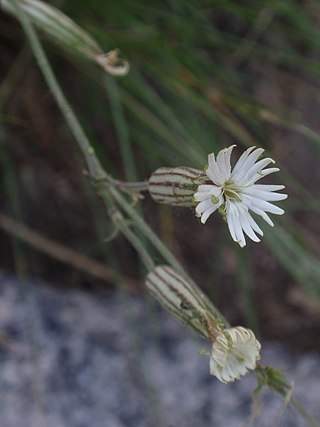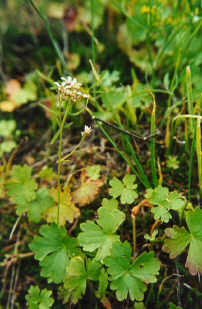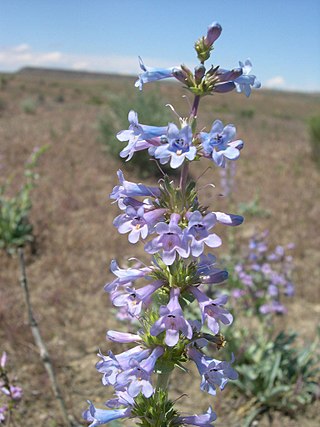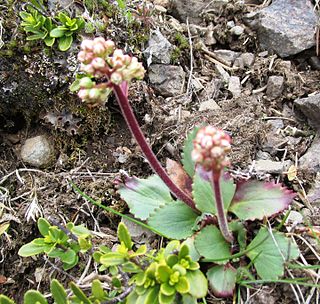
Galeopsis tetrahit, the common hemp-nettle or brittlestem hempnettle, is a flowering plant in the family Lamiaceae, native to Europe and northwestern Asia.

Ranunculus glaberrimus, the sagebrush buttercup, is a species of flowering plant in the buttercup family, Ranunculaceae. It is native to interior western North America, in western Canada, the western United States, and the northwestern Great Plains.

Primula pauciflora, the pretty shooting star, few-flowered shooting star, dark throat shooting star or prairie shooting star, is a species of flowering plant in the primula family Primulaceae. It is a widespread and very variable species, native to western North America, from Subarctic America to Mexico, often in xeric and desert habitats. It is found in the Great Basin Deserts and Mojave Desert. Its synonyms include Dodecatheon pauciflorum and Dodecatheon pulchellum.

Epilobium hirsutum is a flowering plant belonging to the willowherb genus Epilobium in the family Onagraceae. It is commonly known as the great willowherb, great hairy willowherb or hairy willowherb. Local names include codlins-and-cream, apple-pie and cherry-pie.

Chaenactis douglasii is a North American species of flowering plant in the daisy family known by the common name Douglas' dustymaiden.

Veronica wormskjoldii is a species of flowering plant in the plantain family known by the common name American alpine speedwell. It is native to much of northern and western North America, including the western United States and northern Canada, from where it grows in moist alpine habitat, such as mountain forest understory. It has a wide subarctic distribution from Alaska to Greenland. It is named after the Danish botanist Morten de Wormskjold (1783-1845) who had studied under professor Jens Wilken Hornemann (1770-1841) and had reportedly collected 157 species of vascular plants during an expedition to Greenland in 1812-1813, more than doubling the then number known. The expedition was manifestly to collect specimens for the Flora Danica and was financed by Wormskjold's father, though Hornemann sponsored chancery secretary Friedrich Gustav Heiliger (c.1789-) as botanical draftsman, paid for by the royal treasury. He stayed in Nuuk and in the vicinity of Qaqortoq and was helped to collect the plant specimens by the local Greenlandic population, which Wormskiold described.

Penstemon anguineus is a species of penstemon known by the common name Siskiyou penstemon. It is native to the mountains of southern Oregon and northern California, where it grows in coniferous forests, often in open areas left by logging operations.

Penstemon californicus is a species of penstemon known by the common name California penstemon. It is native to Baja California and is also known from fewer than 20 occurrences in California, mainly in Orange and Riverside Counties. It grows in the forest and woodland habitat of the Peninsular Ranges and nearby slopes.

Silene bernardina is a species of flowering plant in the family Caryophyllaceae known by the common name Palmer's catchfly.

Nestotus stenophyllus is a species of flowering plant in the family Asteraceae known by the common name narrowleaf mock goldenweed. It was previously known as Stenotus stenophyllus. It is native to the western United States, especially the inland Pacific Northwest and northern Great Basin, where it grows in sagebrush habitat usually in rocky soil.

Hemieva ranunculifolia is a species of flowering plant in the saxifrage family known by the common name buttercup suksdorfia. It is the sole species in genus Hemieva. It is native to western North America from British Columbia and Alberta south to northern California. It grows in moist, rocky habitat in mountains and foothills. It is a non-rhizomatous perennial herb growing up to 40 centimeters tall. The leaves have rounded blades up to 4 centimeters wide with several large lobes edged with rounded teeth. The blades are light green, slightly fleshy, hairless in texture, and are borne on petioles up to 15 centimeters long. The inflorescence is a dense, flat-topped cluster of up to 35 flowers borne atop a mostly naked, hairy, glandular stalk. Each flower has a bell-shaped calyx of pointed sepals and five white or pink-tipped petals. The fruit is an oval brown capsule measuring 4 millimeters in length.
Silene seelyi is a species of flowering plant in the family Caryophyllaceae known by the common names Seely's catchfly and Seely's silene. It is endemic to Washington state in the United States, where it is limited to the Wenatchee Mountains of Chelan and Kittitas Counties.

Penstemon acuminatus is a species of flowering plant in the plantain family known by the common names sharpleaf penstemon and sand-dune penstemon. It is native to the dry interior of the northwestern United States.

Micranthes occidentalis, commonly known as western saxifrage, is a species of flowering plant native to North America.

Penstemon auriberbis, commonly known as the Colorado penstemon or Colorado beardtongue, is a species of Penstemon that grows in the shortgrass prairies of southern Colorado and in a few places in northern New Mexico. Although specimens were collected on the 1820 expedition by Stephen H. Long through the area, they were not scientifically described as a separate species until 1920.

Penstemon gairdneri is a species of perennial plant in the Plantaginaceae family with the common name Gairdner's beardtongue. It is native to Washington, Oregon, and Idaho in the western United States.

Penstemon albifluvis, the White River penstemon, is a disputed species or variety of Penstemon that grows in a small area in eastern Utah and western Colorado. It grows mainly on broken shale and rock formations in desert habitats. White River penstemon is very rare.

Penstemon confertus is a species of flowering plant in the plantain family; its common name is the Yellow beardtoungue. It is native to the US states of Washington, Idaho, and Montana, and the Canadian provinces British Columbia and Alberta.

Penstemon richardsonii is a species of flowering plant in the plantain family; its common name is cutleaf beardtongue or Richardson's beardtongue. It is native to the US states of Washington, Oregon and the Canadian province British Columbia.

Penstemon breviculus, the narrow-mouth penstemon or shortstem penstemon, is a species of perennial flowering plant from the dry forests and steppes of the Colorado Plateau in the western United States.























